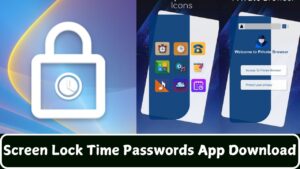Screen Lock Time Passwords App Download
A screen lock time password is a security measure that protects devices like smartphones, tablets, and computers by requiring a password, pattern, or biometric data to unlock after a period of inactivity. This feature helps secure sensitive information and prevents unauthorized access, which is essential for personal data protection and compliance with organizational security policies.

Types of Screen Lock Time Passwords:
- Numeric PIN: Simple and quick to use, but less secure than other options.
- Alphanumeric Password: More secure due to the combination of letters, numbers, and special characters.
- Pattern Lock: Allows users to draw a pattern on a grid but can be easy to replicate if observed.
- Biometric Locks: Uses fingerprints, facial recognition, or iris scans for quick access, offering high security.
- Smart Locks: Automatically unlocks under specific conditions, like trusted locations, but may compromise security.
Functionality:
When a device is idle for a specified period, the screen lock time feature activates, requiring the correct password or biometric input to regain access. Users can adjust the timeout duration based on their security needs, with shorter durations providing better protection.
Best Practices:
- Use strong passwords combining letters, numbers, and symbols.
- Enable biometric locks for faster, secure access.
- Set an appropriate lock timeout for the best balance between security and convenience.
- Avoid common patterns and change passwords periodically.
Benefits:
- Enhanced Security: Protects sensitive data on devices.
- Compliance with Data Regulations: Meets security requirements for organizations.
- Prevents Accidental Use: Helps avoid unintentional device operations.
Drawbacks:
- Inconvenience: Constantly unlocking the device may be annoying, especially with shorter timeouts.
- Lockout Risks: Forgetting passwords or biometric failures can result in lockouts.
- Observation Vulnerability: Patterns and passwords can be seen by others.
Advanced Features:
Some devices offer additional features like two-factor authentication (2FA), remote lock/erase capabilities, and customizable lock screens. Organizations can enforce mobile device management (MDM) policies to mandate screen lock settings for employees.
Future Trends:
Advancements may include AI-powered security for detecting unusual behavior and multi-modal authentication, which combines multiple security methods for better protection.
Overall, screen lock time passwords are crucial for securing modern devices, and using best practices can help maximize their effectiveness in safeguarding data.A screen lock time password is a security measure that protects devices like smartphones, tablets, and computers by requiring a password, pattern, or biometric data to unlock after a period of inactivity. This feature helps secure sensitive information and prevents unauthorized access, which is essential for personal data protection and compliance with organizational security policies.
Types of Screen Lock Time Passwords:
- Numeric PIN: Simple and quick to use, but less secure than other options.
- Alphanumeric Password: More secure due to the combination of letters, numbers, and special characters.
- Pattern Lock: Allows users to draw a pattern on a grid but can be easy to replicate if observed.
- Biometric Locks: Uses fingerprints, facial recognition, or iris scans for quick access, offering high security.
- Smart Locks: Automatically unlocks under specific conditions, like trusted locations, but may compromise security.
Functionality:
When a device is idle for a specified period, the screen lock time feature activates, requiring the correct password or biometric input to regain access. Users can adjust the timeout duration based on their security needs, with shorter durations providing better protection.
Best Practices:
- Use strong passwords combining letters, numbers, and symbols.
- Enable biometric locks for faster, secure access.
- Set an appropriate lock timeout for the best balance between security and convenience.
- Avoid common patterns and change passwords periodically.
Benefits:
- Enhanced Security: Protects sensitive data on devices.
- Compliance with Data Regulations: Meets security requirements for organizations.
- Prevents Accidental Use: Helps avoid unintentional device operations.
Drawbacks:
- Inconvenience: Constantly unlocking the device may be annoying, especially with shorter timeouts.
- Lockout Risks: Forgetting passwords or biometric failures can result in lockouts.
- Observation Vulnerability: Patterns and passwords can be seen by others.
Advanced Features:
Some devices offer additional features like two-factor authentication (2FA), remote lock/erase capabilities, and customizable lock screens. Organizations can enforce mobile device management (MDM) policies to mandate screen lock settings for employees.
Future Trends:
Advancements may include AI-powered security for detecting unusual behavior and multi-modal authentication, which combines multiple security methods for better protection.
Overall, screen lock time passwords are crucial for securing modern devices, and using best practices can help maximize their effectiveness in safeguarding data.
